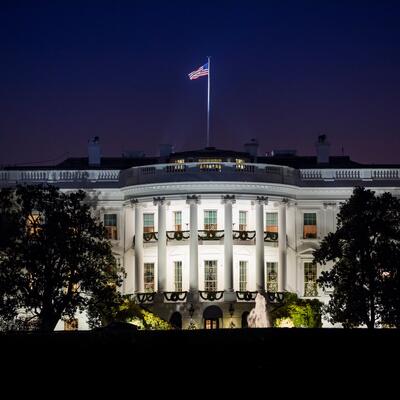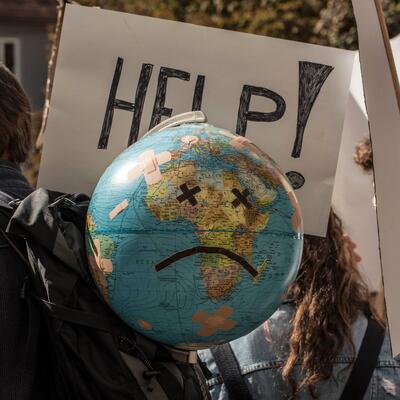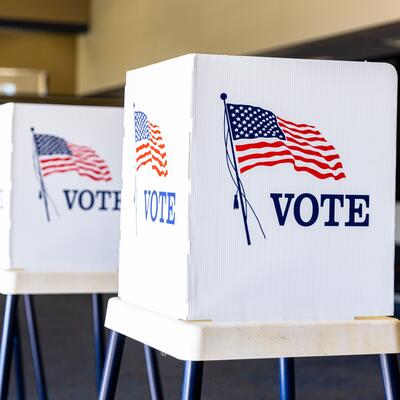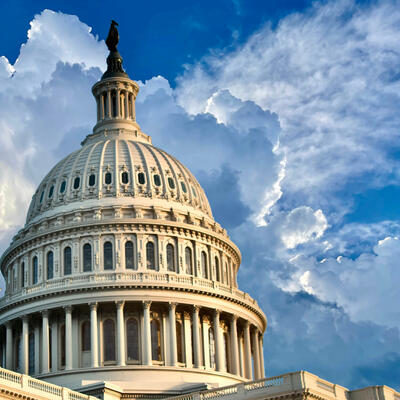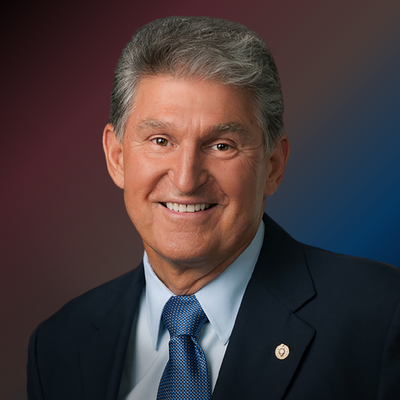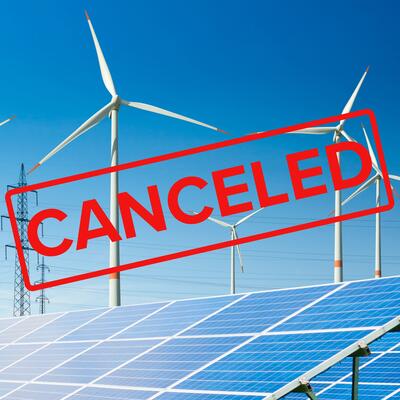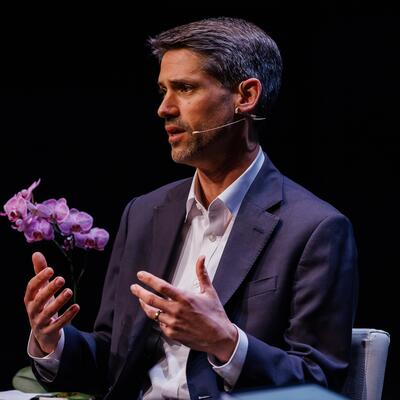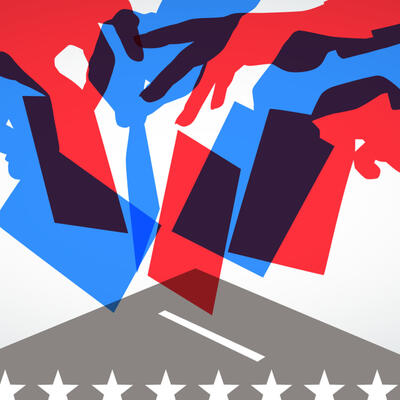
Political Climate: The Midterm Forecast
Guests

Nathaniel Stinnett

Chelsea Henderson

Jean Chemnick
Summary
With the US midterm elections looming, the window for enacting meaningful climate policy may be closing. November’s elections will decide which party controls Congress, and that will have far reaching implications for the planet. Historically, the midterms have been bad news for the party in control of the White House, but the Dobbs decision by the Supreme Court overturning Roe v. Wade and the passage of the Inflation Reduction Act may have changed that calculus. Nathaniel Stinnett, Founder & Executive Director of the Environmental Voter Project, explains where he believes the races stand at the moment:
“The prospects for Republicans flipping the House remain better than even. I wouldn't call them really, really strong, but better than even. And that's for two reasons. One, incumbent presidents usually seem to lose the House. And two, we just had a round of redistricting. And in the majority of states Republicans were able to really nail down a lot of safer gerrymandered districts. But the story in the Senate is different. Six months ago…I would've said, Republicans might take back the Senate. Now, I think there's a greater likelihood that the Democrats might pick up a seat, but we're talking about a whole bunch of close elections in four or five states that could go either way. So, it's gonna be a surprise to pretty much everybody what happens in the Senate.”
So where does climate rate on the list of issues voters consider when casting their ballots? Stinnett explains, “The good news is that when we look at voters’ long-term priorities, 9% of them listed climate and the environment as their number one priority over all others. Now that might not seem like a lot...But…it was enough to put climate in the environment in third place. Right behind inflation and cost-of-living which 30% listed as their top long-term priority. And then 13% said economy and jobs. The problem is most people don't go and cast their ballot thinking about how they want to impact the world 5, 10, even 20 years from now. And when instead, we asked what people's current priorities are, we were lucky if 4% of likely voters listed climate and the environment as a top priority.”
Democrats definitely talk and do more about the climate crisis, though bills that have clean energy provisions - such as the Infrastructure and Jobs Act, and the CHIPS and Science Act - did draw some Republican votes. Chelsea Henderson, Director of Editorial Content for RepublicEN and host of the podcast EcoRight Speaks, sheds some light on how climate priorities are evolving on the right:
“If you are a Republican voter, you can expect that those candidates have some sort of position on climate change. It's really no longer cool to just say it isn't happening. We have too much anecdotal evidence, let alone all the scientific evidence. I don't think people are buying that any more. And more and more what I'm seeing is members wanting to have something they can show, whether its constituents back home who might be concerned or future voters they want to show something that they’re for.”
Another recent example of bipartisan climate action was the US Senate’s ratification of the Kigali Amendment to the Montreal Protocol. This is a huge deal, because enacting the amendment could reduce warming by 0.5°C, by eliminating the use of HFCs or hydrofluorocarbons.
Jean Chemnick, Climate Reporter for E&E News, explains that what enabled bipartisan support was that American industry could gain financially from the deal. “The Kigali Amendment, of course, only addresses a fairly narrow slice of the climate problem. It's just HFCs, which are used in a fairly narrow set of products. And industry wasn't just supportive of it, they were passionately supportive of it. US companies, many of which are actually in states that are sort of red states represented by Republican senators. They were the ones who held the patents to the alternatives.”
Related Links:
Environmental Voter Project Polling Data
EcoRight Speaks Podcast
Why Republicans Support Kigali
Full Transcript
“Note: Transcripts are generated using a combination of automated software and human transcribers, and may contain errors. Please check the actual audio before quoting it.”
Greg Dalton: This is Climate One. I’m Greg Dalton.
Ariana Brocious: And I’m Ariana Brocious.
Greg Dalton: It seems like every presidential election cycle we hear that people need to get out and vote because it’s the “most important” election in our lifetimes. Yet, midterm elections are also really impactful.
Ariana Brocious: That’s true, with the window closing for meaningful climate action, every election cycle is incredibly important. Especially coming off the weather related disasters we’re seeing so much more frequently such as the destruction in Florida in the wake of Hurricane Ian and in Puerto Rico from Hurricane Fiona.
Greg Dalton: The US isn’t the only country facing important elections. In Brazil the current presidential election couldn’t offer a more stark choice.
Ariana Brocious: Right, Jair Bolsonaro s the current president who trends toward right wing authoritarianism. He’s running against Luiz Inácio Lula da Silva, the former president and left-wing populist.
Greg Dalton: Brazil is an incredibly important country when it comes to climate concerns. Bolsonaro seems bent on doing everything he can to sell off and destroy Brazil’s natural resources, such as the Amazon rainforest. Another Bolsonaro term in office could further erode the power of the world’s lungs and continue increasing emissions driven by deforestation. In contrast, Lula has a strong climate and conservation record and made new promises for sustainability and emissions reductions ahead of the election.
Ariana Brocious: On October 2nd, Brazil had their first round of elections. While polls had predicted a likely win for Lula, Bolsonaro showed surprising strength. Lula received 48% of the vote and Bolsonaro received 43%. Since neither candidate made it over the 50% threshold, they now go to a runoff election on October 30th.
Greg Dalton: That Brazil election will be about a week before the US midterms. A few months ago it looked like the Democrats were in for a shellacking, but a series of events has changed that outlook.
Ariana Brocious: That’s right. The US Supreme Court has made a jarring shift rightward, with the Dobbs decision overturning Roe v Wade. And gasoline prices - the most visible energy price Americans see every day - have come down.
Greg Dalton: And the Biden administration was able - finally - to pass the Inflation Reduction Act, the most meaningful climate legislation in our country’s history. Paired with the Infrastructure Investment and Jobs Act and the CHIPS and Science Act, there is really significant movement on the transition to clean tech and renewable energy. All that has helped push President Biden’s Approval from 38 percent to 42 percent over the past couple of months. That’s not great, but it’s better than it was.
To find out just what the outlook is for the midterm elections, I invited Nathaniel Stinnett, Founder & Executive Director of the Environmental Voter Project, to give us a picture of where things stand.
Nathaniel Stinnett: So, I think that the prospects for Republicans flipping the House remain better than even. I wouldn't call them really, really strong but better than even. And that's for two reasons. One, incumbent presidents usually seem to lose the House. And two, we just had a round of redistricting. And in the majority of states Republicans were able to really nail down a lot of safer gerrymandered districts. But the story in the Senate is different. I think if you would ask this question six months ago, Greg, I would've said, Republicans might take back the Senate. Now, I think there's a greater likelihood that the Democrats might pick up a seat, but we're talking about a whole bunch of close elections in four or five states that could go either way. So, it's gonna be a surprise to pretty much everybody what happens in the Senate.
Greg Dalton: And that’s in line with some of the polling and probability models out there. And yet how much faith do you put in polls given their poor performance in ‘18 and ’20?
Nathaniel Stinnett: I think to borrow a line from Ronald Reagan you know trust but verify. I trust a little bit in polls because they’re the best we've got. But I verify based off non-polling data. And it turns out that we've got some pretty good non-polling data. I'd say the best of which are special elections. We've seen recent special elections in Alaska and Nebraska and Kansas and New York and Minnesota, all of which are, well, either in line with polling or show more democratic strengths than the polls pick up. So, I guess what I would say is pollsters themselves would tell you that they're not confident that they figured everything out. The pollsters themselves are pretty nervous. But going into the upcoming midterms I don't think we can say that if there is polling error it will work against Democrats. Because all of the recent special elections we've seen have seen Democrats overperform their polls. So, I don't rely on the polls, but they're not scaring me in the way they have in the past.
Greg Dalton: Well, the first President Bush talked about the “Big Mo,” momentum and “Big Mo” seems to be on Democrats’ side, this time. Later in this episode we hear from Chelsea Henderson who talks about new registrations, new voters being young and women who tend to care more about the environment. So, do you think that there is sort of some kind of intangible “Big Mo” in play the cycle?
Nathaniel Stinnett: Absolutely. And I'm not even sure I would call it intangible. I think it's very tangible and very clear that there is momentum and where it's coming from. If we think of a hierarchy of emotions, Greg, that can drive turnout, the last thing you want is disengagement. And that's kind of what we saw was this feeling of disappointment and disengagement among environmentalists last spring. But then with the passage of the Inflation Reduction Act you get people getting a lot more excited. And with the Supreme Court Dobbs decision you get people getting scared and angry and those are emotions, excitement, fear, anger, that really, really drive turnout, especially among progressives right now. And so, yeah, I do think that progressives and also just a broader environmental movement whether you're progressive or middle-of-the-road or conservative. If you care deeply about climate, the passage of the Inflation Reduction Act is really getting you fired up. You feel like you got the wind in your sails in a way that you've never really had before.
Greg Dalton: So, you're saying is, this combination of policy and emotion. Policy is not often thought about exciting, but policy and emotion are coming together to generate this political landscape right now.
Nathaniel Stinnett: That's right. Don't get me wrong, I don't think people run down the street with like a wheelbarrow full of Inflation Reduction Act provisions. You know, the policy doesn't really get them excited, but nothing succeeds like success. And getting a really big win. I mean not just the biggest federal climate legislation in history, but you could argue the only federal climate legislation in history, that's a big win and wins beget wins and it makes you feel good and confident and it really fights that feeling of disappointment, which is just kryptonite if you're in the voter turnout business. You don't want people to be disappointed. You want them to be excited or you want them to be worried. And so, we really see growing engagement and growing excitement in these environmentalists whom we target at the Environmental Voter Project.
Greg Dalton: And Main Street is concerned about gas prices, electricity prices, you know, they're down, gas prices, at least a little bit recently though that's what people see and feel every day. So, how is that playing in races that you're looking at?
Nathaniel Stinnett: There is no doubt that even though the numbers of people who care deeply about climate change and the environment are growing they are still far, far behind the populations of voters who list inflation and the cost of living and jobs in the economy and even other issues like healthcare and abortion as their top priorities.
Greg Dalton: Right. And how much of that though is, you know, climate can also be labeled energy or other things, right. People don't care about climate, but I care about gas prices my electric bill. So, does that reframing help increase those numbers of concern?
Nathaniel Stinnett: It helps it on the margin, but really only on the margin. So, don't get me wrong, I think it is enormously important to be nuanced and careful about how we message energy security and clean energy and green jobs and everything around the climate crisis and that really matters. It really matters. But I think we often over intellectualize what is going on in voters’ minds when they cast ballots. And chances are they only have the bandwidth for a few emotions and a few ideas. And right now, even the best messaging in the world isn’t translating in the tens of millions of climate first voters showing up and casting ballots. So, yeah, the messaging nuance makes a difference, but not in an earthshaking way.
Greg Dalton: So, when people go, do they vote on emotions and issues and do they vote on short-term outcomes or long-term outcomes?
Nathaniel Stinnett: They vote on short-term outcomes. I mean we just did a round of polling in four battleground states at the Environmental Voter Project. So, we pulled over 3000 voters in Arizona, Georgia, Nevada and Pennsylvania. And the good news is that when we look at voters’ long-term priorities, 9% of them listed climate and the environment as their number one priority over all others. Now that might not seem like a lot.
Greg Dalton: Yeah, like that's good news? 9%?
Nathaniel Stinnett: Right, right. But, Greg, it was enough to put climate in the environment in third place. Right behind inflation and cost-of-living which 30% listed as their top long-term priority. And then 13% said economy and jobs. The problem is most people don't go and cast their ballot thinking about how they want to impact the world 5, 10, even 20 years from now. And when instead, we asked what people's current priorities are, we were lucky if 4% of likely voters listed climate and the environment as a top priority, and that was way, way down. Now is, you know, 10th or 11th on the list. Now, the good news in that is that it's almost twice as much as what we saw back in 2018. The last time we had a midterm election. So, I don't want to make it seem like I’m all doom and gloom here. The climate movement is getting bigger and we are also getting politically stronger. And that's part of the reason why we’re not just seeing leadership on climate at the federal level but also at the state and local level. But we’re nowhere near where we need to be. Nowhere near where we need to be because at the end of the day nothing motivates a politician more than the prospect of winning or losing an election. And when you've only got three or four or 5% of voters listing an issue as their top priority, boy, is it hard to justify spending your political capital on that.
Greg Dalton: Are you saying that we get the climate policy that the people want? That politicians are not doing more because voters are not ranking it highly that we kind of get what we deserve.
Nathaniel Stinnett: I think that's a fair question. I wouldn't put it as we get what we deserve because there are a few important variables going on here. The first is, boy, is there a big difference between how politicians treat the priorities of voters versus nonvoters. So, in this recent round of polling that we did in Pennsylvania and Nevada, two crucially important battleground states this fall, twice as many nonvoters listed climate as a top priority as likely voters did. So, that's really important to understand that there are lots of people, twice as many people who care deeply about climate and the environment who aren't voting as those who are voting. And so, we really need to understand that politicians like to win elections. And so, they're going to appeal to people who actually cast ballots, not the ones who don't cast ballots.
Greg Dalton: So, help me understand the mind of a person who cares about climate, which to me says you care about the environment, your children, ecosystems, human survival and you don't vote. That one baffles me.
Nathaniel Stinnett: Yeah, so there are a few things going on here and it meshes well with your previous question about like is this about we get what we deserve and things like that. First off when we talk at the Environmental Voter Project about environmentalists, we obviously have a very unique definition like most groups have a unique definition. We’re a voter turnout organization so we’re going after these super environmentalists. These are people who have a high likelihood of listing climate or the environment as their number one priority over all others. So, you ask what's their mindset, why aren’t they voting? Well, the first thing is when we look at these climate first people, they are disproportionately young disproportionately people of color and disproportionately lower income.
Greg Dalton: So, they’re marginalized in other ways.
Nathaniel Stinnett: They’re marginalized in other ways. Moreover, Greg, if anybody anywhere is trying to make it harder for someone to vote, chances are those voter suppression campaigns are targeting young people, people of color or poor people and that is the beating heart of the modern environmental movement. So, part of what's going on here is just old-fashioned voter suppression is taking a big chunk out of the environmental movement's political power. But the second thing and there is less evidence for this, but it really does ring true and so, I think it's worth talking about is that for over a generation the environmental movement has viewed activism in weirdly apolitical ways. And I know that's kind of a dramatic statement so let me explain. Chances are growing up if you thought about what it meant to have an impact on the environment, you thought about recycling or not littering or changing how you get to work or changing the electricity you consume or changing the food that you eat all of which are important, don't get me wrong. But they're strangely apolitical, right, like you would never hear an NRA member talk that way or someone who cares about reproductive rights talk that way. And it's by design --
Greg Dalton: It’s all in the frame of individual action and individual responsibility.
Nathaniel Stinnett: That's exactly right. And, you know, I'm not a conspiracy theorist here. There's a lot of really good research showing that like this was a PR campaign by the fossil fuel industry. They didn't want you to pay attention to that coal-fired power plant behind them. So instead, they pointed their finger at the plastic water bottle in your hand and they said this is all your fault, change your personal behavior and stop paying attention to the big political systemic stuff. Which is of course absurd, but I see why they did it.
Greg Dalton: The Crying Indian in the American Beverage Council in the 1970s, yeah.
Nathaniel Stinnett: That’s exactly right. And I can't help but feel that that is a big part of why people who care deeply about climate and the environment aren't at least inherently politically engaged. They don't start off politically engaged because we’ve got to catch up. We've got to make up some ground in a way that people who care about other issues don't have to because they've always viewed gun control as political or they've always viewed reproductive freedom as political.
Greg Dalton: This is Climate One. I’m Greg Dalton. Our podcasts typically contain extra content beyond what’s heard on the radio. If you missed a previous episode, or want to hear more of Climate One’s empowering conversations, subscribe to our podcast wherever you get your pods.
It’s often said that young people are “climate voters.” And many assume that older people care less about climate because they won’t live to see it get worse. But that isn’t necessarily the case. Nathaniel Stinnett, of the Environmental Voter Project, explains what he’s seeing in the data.
Nathaniel Stinnett: Yeah, so there is no doubt that young people are far more likely to list climate as a top priority than older people. Although, Greg, there's some nuance there that I don't think we should overlook. We actually see, if you imagine a graph in front of you, kind of a U where the left end of the graph, yeah, the young people, you know, huge numbers of them care deeply about climate and the environment. And then when you get into Gen X very, very few of them list climate or the environment as a top priority. But then when you get into people in their 60s and 70s increasing numbers of them do list climate and the environment as a top priority. So, it's not as simple as saying the younger you are, the more likely you are to care about climate, but you are right that by overwhelming numbers young people are the most likely to care about climate and they are also the most likely to be what's called drop-off voters. So, people who vote in presidential elections, but nothing else. And so, yeah, we go into every midterm cycle thinking, oh, if only young people show up, all these amazing things are going to happen and then you know sometimes their turnout ticks up three or four percentage points, sometimes it doesn't. I can tell you what we saw, not just in 2018 but in 2020, was disproportionately high turnout from young people compared to previous years. But young people didn't over perform in a bigger way than other age demographic groups did. So, another way to put it is yeah youth turnout went up, but it didn't go up that much more than all the other age groups went up. So, what will be interesting to see is obviously what happens this November. But I am coming around to the view, Greg, that we’re just in a new voter turnout world now. And something happened after the 2016 election and since then I mean I haven't seen a single low turnout election, just period. Even local elections are having much higher turnout than the previous instances of those local elections.
Greg Dalton: So, does that mean suppression efforts are not working. How can there be suppression if more people are voting?
Nathaniel Stinnett: Well, there can always be suppression. I mean just because there is a tide of new voters coming doesn't mean there aren't people building up huge walls to try to keep it out. And there are very, very real voter suppression efforts working right now. I mean, dramatically reducing the number of polling places in Arizona, minimizing the voting hours in Texas and Georgia. In this battleground poll that we did at the Environmental Voter Project in July we saw that a quarter of black voters in Georgia thought it was very complicated or somewhat complicated to vote where as I believe only four or 5% of white voters did at Georgia. And that tells you voter suppression efforts against the black community are working. They are working not just because they are actually making it harder to vote, but even more than that they’re making people think that it's harder to vote. And take it from someone who's in the voter turnout business, you win or lose your battle before a vote or even opens their door to walk to the polling place on election day. You want them before they even make that decision to think that it's going to be easy to think that it's not gonna be complicated to think that they can just go there and do it. And if you scare them into thinking it's gonna be a whole big ordeal, well, voter suppression campaigns have already won.
Greg Dalton: One of the headlines of the 2020 election was Hispanics moving to the right and embracing the former president. Hispanics, especially Hispanic women are often seen as strong environmentalists, in part because they often live near freeways, factories and other sources of pollution. So, how do you see this shift in a group that Democrats have frankly taken for granted. Some people talk about Hispanics as the new swing voter.
Nathaniel Stinnett: So, I think it is important to both understand the trends but also not forget the baselines. So yes, have Hispanics over the last five, six years been moving towards Republicans? Definitely. But they started from a point where Democrats usually won, you know, 70% of the Hispanic vote and now it's more like 60% of the Hispanic vote. So, I wouldn't characterize it as sort of a true tossup yet but there's no doubt that there is that trend happening. Now, what we're seeing in the environmental movement and in our data at the Environmental Voter Project is that, boy, does it vary depending upon the country or territory of origin that Hispanics come from and when they came to the continental United States. So, first let me sort of give you the big picture and then drill down on some nuance, Greg. So, big picture in our battleground state polling 9% of Hispanics said climate was the most important factor when choosing a candidate. And that compared to only about 5% of white voters. So yes, overall as a topline issue Hispanics are much more likely to care deeply about climate than white voters are. But when we dig into our state voter files and look at some of our other data, we see that Hispanics are much more likely to prioritize climate change in states like Arizona, Georgia, North Carolina than they are in Texas or Florida. And this gets to those two variables that I just mentioned, Greg. If you look at Hispanics County or territory of origin. Hispanics from Cuba, Venezuela and other dictatorships are much more likely to be politically conservative than Hispanics from Mexico, Puerto Rico, Central America or other places. So, that's one really important variable that leads to diverging priorities around climate change.
Greg Dalton: So, the authoritarian-led countries or the Democrat countries is what I heard there.
Nathaniel Stinnett: That's right. That's right. The second variable is that foreign-born first-generation Hispanics are much more likely to see climate as a top priority than Hispanics who have been in the continental United States for more than a generation, in part, I would imagine, because those more recent arrivals are actually climate refugees, many of them are climate refugees. They’re escaping hurricanes or drought or many of the conflicts that arise from parts of the climate crisis. And so, we’re seeing all of these different variables lead to very interesting nuances that end up having pretty significant political consequences. It ends up meaning that if you live in the middle of Florida along the I-4 corridor, well, there Hispanics are much more likely to care deeply about climate and the environment, than maybe the Cubano and Venezuelan communities in South Florida. Or Hispanics along the border in Texas are much less likely to care about the climate crisis, than the Latina grandmother who’s living outside Phoenix. And I'm painting with really, really broad-brush strokes here, but we really are seeing these differences in our data.
Greg Dalton: So, let's walk around some of these key states where you’re doing polling, etc. where energy may or may not be playing.So, Pennsylvania has a long said that candidates can't be critical of fracking or lead on climate if they want to win, particularly in western Pennsylvania. So, what's at play in Pennsylvania and how you see it this midterm election in Pennsylvania?
Nathaniel Stinnett: So, Greg, you're absolutely right that conventional wisdom in Pennsylvania is that fracking is like the third rail of statewide politics. Don’t even talk about it if you're a Democrat because you’re just cannot open yourself up to an attack. That is not what we’re seeing in our polling data at all, at all. So, when we did this poll in Pennsylvania it was right before the Inflation Reduction Act passed. But I'm almost glad that we did that timing because what we saw was that 44% of independents in Pennsylvania, so, independents, said Democrats in Congress weren't doing enough on climate change, and only 15% of independents said that they were doing too much. So, by a 3 to 1 margin independents in Pennsylvania said we want Democrats to do more on climate. I mean that’s pretty extraordinary. When you're running in Pennsylvania, you know, if you can have independents break 3 to 1 for you on a particular set of issues, you are golden. And so, I'm not claiming that climate is going to be the sole driver of the elections in Pennsylvania this cycle of course it isn't. But that really pushes against that conventional wisdom that a lot of people have about extractive industries in Pennsylvania. Also, the reason why this is so important is oh my gosh is Pennsylvania gonna be important this cycle. We've got essentially a tossup U.S. Senate race, a tossup gubernatorial race, four really competitive congressional elections, and both a statehouse and a state Senate that are superduper close. So, pretty much anybody casting a ballot anywhere in Pennsylvania is going to see tight races up-and-down their ballot this November. Pennsylvania voters have a ton of power this fall.
Greg Dalton: What are some other congressional districts that might be surprises that might determine control of the House?
Nathaniel Stinnett: New York is surprisingly important this cycle, in part because Democrats in New York try to really aggressive gerrymander that was thrown out by the courts at the last minute they had to quickly redraw their maps and there are a surprising number of competitive districts in New York State. So, based on the Cook Political Report, nine of New York's congressional districts are currently competitive. That is more than any other state except for California, which has 10. And if you compare that to say, Texas, Texas only has three competitive House races. So, nine is a huge number and they're all pretty geographically concentrated. There are four tight districts on Long Island, four tight districts going up the Hudson Valley and then a tight district around Staten Island. And so, I would wager that if the House remains close, when your listeners sit down on election night to watch returns roll in. CNN is gonna be spending a lot of time focused on the Hudson Valley of New York, which is the last thing most people would expect. But boy, are there a lot of close races.
Greg Dalton: Last year, we saw the electric grid in Texas failed during frigid temperatures because of mismanagement of fossil fuels. Texas is also producing a large amount of wind energy. Are people in Texas coming around on climate and renewables or how is that forming in Texas?
Nathaniel Stinnett: They are coming around on climate and renewables. But it is more due to people moving into the state of Texas than people who have been in Texas for a long time changing their minds. You know Texas has some of the fastest growing cities in the country. I mean Austin, I mean it seems like a thousand people move into Austin every single day. And San Antonio and El Paso and Houston and Dallas they’re just growing at an enormous speed. And those people are often bringing opinions and priorities with them that I mean they care more about climate than the neighbors they move next to who have been there for a generation. And so, yes, at the Environmental Voter Project, for instance, we've identified over 630,000 climate first registered voters in Texas who have never voted in a midterm. So, these are really important turnout targets. But, Greg, even though those numbers are big and even though they’re growing, will they be enough? I don't know.
Greg Dalton: One state on the front lines of dealing with climate impacts is Florida where they’re seeing sea level rise, increased intensity of hurricanes if not increased frequency. So, how does the climate factor into Florida voting?
Nathaniel Stinnett: For a pinkish red state like Florida is, a state that usually trends 2 to 4 points more Republican than the national average, a surprisingly large percentage of voters list climate and other environmental issues as their top priority. That's why more than almost any other state you even see some moderate Republicans, not just sort of checking the right boxes on climate in Florida, but really talking about climate change, as though it's a real issue. But again, I don't want to overstate this Greg. It isn't like we’re going to see the Senate candidates and the gubernatorial candidates spending 20% of their time talking about climate. What we’re talking about here is instead of 4% of voters listing it as a top priority, polls usually have anywhere from 6 to 9% of voters listing it as a top priority in Florida. But obviously the big variable is always extreme weather in Florida where you have algae blooms, you have floods, you have hurricanes. And these exogenous variables really drive politics. They really drive politics.
Greg Dalton: Let's bring it home, last question. A particular race and a particular individual, Mary Peltola is a recent winner of a special election to replace Don Young in the House of Representatives. The single member of the house for Alaska. She signed a letter to Interior Secretary. Deb Haaland asking her to approve a proposed oil development in the national petroleum reserve Alaska, not the national, it’s different from ANWR, it’s the Willow project. So, here is a person saying please approve this petroleum extraction project. What does that say about how energy is playing in that race? Of course, Alaska is a big oil state.
Nathaniel Stinnett: I think that it is another example of politicians going where the votes are. I'm not claiming that Mary Peltola is awful on climate and environmental issues. In fact, I think you can make an argument that she's very good on a lot of environmental issues. But there is no doubt that in Alaska there are more votes to be mined, pardon the pun, from protecting the fossil fuel industry than fighting against it. And this is an illustration of how even when the climate movement gets the so-called right person elected. They can't just snap their fingers and spend their political capital on something that most voters don't view as a really high priority. And so, it's not just about electing the right people. It's also about giving them the demand for climate leadership in the political marketplace that they need to be good leaders on this stuff. So, people like Mary Peltola right now are looking at their voter files and they’re looking at their polling data and they're saying, gosh, how can I get to 50% plus one of the votes? Do I do it by riling up climate activists? Or do I do it by making sure Alaskans know that I'm not as scary on fossil fuels as they might think. And the truth is, it's the latter right now. I wish it were the former. I wish we had so much power in Alaska that we could scare Mary and everybody else into being amazing climate leaders on every single issue but we’re not there yet, Greg, we’re not there yet.
Greg Dalton: Nathaniel Stinnett, Founder and Executive Director of the Environmental Voter Project. Thanks for coming on Climate One.
Nathaniel Stinnett: My pleasure, Greg. Thank you so much for having me.
Greg Dalton: This is Climate One. I’m Greg Dalton. Democrats definitely talk and do more about the climate crisis, though bills that have clean energy provisions - such as the Infrastructure and CHIPS Acts - do draw some Republican votes. What is the state of climate action on the right? I invited Chelsea Henderson, Director of Editorial Content for RepublicEN and host of the podcast EcoRight Speaks, to give us a sense of how Republican voters approach climate.
Chelsea Henderson: If you go into your decision-making with the idea that solutions are not something that Democrats have a monopoly on then you can ask tough questions of your candidates. And if you are a Republican voter, you can expect that those candidates have some sort of position on climate change. It's really no longer cool to just say it isn't happening. We have too much anecdotal evidence, let alone all the scientific evidence. I don't think people are buying that any more. And more and more what I'm seeing is members wanting to have something they can show whether it's constituents back home who might be concerned or future voters they want to show something that they’re for.
Greg Dalton: And future voters, there’s a lot of research saying that young Republicans are particularly concerned about climate. How does that message change or how does the importance change around that younger demographic?
Chelsea Henderson: I mean the younger demographic is definitely a game changer. If you look at Gen Z voters plus millennial voters, they are together the biggest voting bloc in history. And they’re climate change native, right, they have been learning about climate change in school, especially Gen Z, their whole lives. As the mother of two Gen Zs I can personally attest to that. They don't just learn it because of our conversations at the dinner table. They are independently worried because of the science classes they’re taking. AP environmental science is really focused on climate change when you get to the high school level. But they get it at all levels of education so they don't come into the issue with that same sort of partisan bent that we see with the older generations. And I think we have seen this bear out with the American Conservation Coalition, Benji Backer’s group. He is, you know, in his early mid 20s now and he felt very passionately that he as a conservative wanted someplace where he could go where he could make, he could push for that change.
Greg Dalton: You say that both parties have climate solutions to bring to the table. We saw the Infrastructure Act that was bipartisan. The CHIPS Act that was bipartisan. Some of that gets to supply chains and manufacturing which have clean energy smart technology applications. Those are bipartisan advancements, though most of the attention has been on the Inflation Reduction Act which passed with one party vote. So, how do those balance out?
Chelsea Henderson: Right. Well, I do think that bipartisanship is important because it creates a sense of durability. You won't have one party wanting to go back and undo something if both parties were part of the process. Unfortunately, with budget reconciliation it's innately a partisan process. At the end of the day as a citizen I have to celebrate the items that were in the Inflation Reduction Act. But, yeah, there are other, you know, we often think especially doing the work that I do, you think about the big-ticket items, right. That cap on carbon or carbon tax. So, these big overarching solutions and sometimes the details kind of fall under the rug. So, Kigali the importance of that cannot be understated. And for listeners that aren't aware this is an amendment to the Montréal Protocol from the 80s is the --
Greg Dalton: Pushed by President Reagan, we should know, right?
Chelsea Henderson: President Reagan and Margaret Thatcher leading the way on that and phased out the use of CFC. So, chlorofluorocarbons which were a very potent greenhouse gas found in air-conditioning, anything that uses a coolant, hair sprays. Now we did not have to eliminate hairspray, right, we just changed what chemicals we use to make these products possible. And unfortunately, we created something that was even worse. Go figure. Humanity is great. No, I’m kidding. We created HFCs hydrofluorocarbons. And so, the Kigali Amendment to the Montréal Protocol which is considered the most successful international environmental treaty in history. The Kigali Amendment will start that phaseout of HFCs and had industry support it had Republican support and environmental support. So, when you have all of those elements in agreement, which is rarer and rarer these days, you know that you've done something really big.
Greg Dalton: The Kigali Amendment is a huge deal that could lead to avoiding 0.5 celsius degrees of warming. Climate One’s Ariana Brocious spoke with Jean Chemnick, climate reporter for E&E News, to learn more about how the amendment garnered bipartisan support in the Senate.
Ariana Brocious: Republicans in Congress have not typically been supportive of climate measures or legislation. The former president pulled out of the Paris Agreement and President Biden promptly rejoined. So why did 21 Senate Republicans vote for the Kigali Amendment?
Jean Chemnick: Well, it's unique in a number of ways. The Kigali Amendment, of course, only addresses a fairly narrow slice of the climate problem. It's just HFCs, which are used in a fairly narrow set of products. And industry wasn't just supportive of it, they were passionately supportive of it. US companies, many of which are actually sited in states that, that are sort of red states represented by Republican senators. They were the ones who held the patents to the alternatives that. You know, the US was already starting to use those alternatives, but if, if it didn't, you know, first create enabling language to, to, you know, comply with the Kigali Amendment, but then actually join. The deal, there would eventually be trade barriers for us companies being able to sell those products abroad. So, you know, they were spending money on lobbying, they were sending letters, they were up there on the hill really talking to their senators. And that is different from, you know, a lot of the climate policies, even policies that have some, you know, industry support, like, for example, methane regulations where, sure, it's perhaps supported, but you know, is it quite to the same degree? Is, is it an, you know, real bread and butter issue for the industry? You know, maybe not as much. Also states retained their regulatory powers and a lot of states were moving to, to regulate HFCs. And that created sort of a patchwork of policy, um, which industry didn't like, you know, and a variety of other things. So, you know, there just was this groundswell of support.
Ariana Brocious: What does this teach us about how to get climate friendly legislation across the finish line?
Jean Chemnick: Well make it a good economic story. This was an, perhaps a uniquely, Republican friendly set of policies for the reasons that we've discussed. But, you know, a good, strong economic story and maybe an element of, you know, this is good for American business for reasons that are really easy to articulate. That helps a lot. And it's possible that as other industries become more powerful, their lobbying muscle will be greater. And, actually that will change the landscape a little bit politically.
Ariana Brocious: And lastly, HFCs were already being phased out in the US thanks to the American Innovation and Manufacturing Act. So why was the ratification of this treaty so important?
Jean Chemnick: Well, even, even if the US was moving away from it domestically, the US needed to ratify Kigali in order to not trigger some of the penalties that are built into the Montreal protocol. In contrast to the Paris Agreement to some other. treaties, there actually are teeth in the Montreal protocol. You, you do end up with trade, uh, penalties if you don't join it. And so the US wouldn't have been able to as easily export some of these alternatives that were actually created in the US to foreign markets starting in 2033.
Ariana Brocious: Jean Chemnick is a climate reporter with E & E News. Jean, thanks for joining us on Climate One.
Jean Chemnick: Thanks for having me.
Greg Dalton: Let’s get back to our conversation with Chelsea Henderson and the possibility of a new Republican Speaker of the House Kevin McCarthy.
Chelsea Henderson: Since the 2018 election when the House flipped back to Democratic control that one thing that Congressman McCarthy noted was that he was losing at the time young voters, and suburban women. And women tend to believe 10 to 20% more than their male counterparts that climate action is something that is important. And so, I think sort of, you know, when you start talking about soccer moms and I think what McCarthy saw is that there are climate moms. And these are the moms of the kids that are learning in school all about climate change. And you layer onto that that more and more Americans are directly experiencing the impacts of climate change. So, the heat waves over the summer at the time of recording Hurricane Ian is bearing down on Florida. The more that people have these very personal encounters with extreme weather events that can be linked back to climate change, the more you’re gonna take seriously the need to act. So, I think that McCarthy saw, you know, maybe I don’t know that he, personally, I've never talked to him, doesn't know that he personally cares about climate change. I think he sees it as an electoral issue for him though. There needs to be again, as I said earlier, you can't just be for nothing you have to be for something. So, he dispatched to his caucus different members to come up with a suite of ideas. And so, initially I believe there were 13 bills that they put on the table and some are bipartisan, some aren't. But that was where we got the Trillion Trees Act. Now, are a trillion trees enough? I have some cynical thoughts about that but as a unit would all these things together make a difference? I hope so. And I hope that if the House does flip control in this next election that he will make good on bringing some of these proposals through the house.
Greg Dalton: Gas prices are coming down around the country, but are still at high levels. How do you think that’s gonna play with voters and is it fair to blame the party in power for gas prices when you, known as RepublicEn on the right side, that the global commodity market determines oil prices, not the government.
Chelsea Henderson: You know, if the president of the party in control, controlled gas prices, gas prices would always be zero, right, gas would be free. So, this idea that we can blame a president for that as you said, it’s a global commodity. I do think though that those fluctuations, they tell a story to the consumer whether it's the right story or not. And so, you know, when people are angry because they feel their budget, they feel their wallet being tightened, then what do they want they want change. So, I do see how there is a, I understand why the disconnect exists it makes me angry but it can have an impact. And I think if you look at all the things that President Biden has done in the last few months, you know, he passed the IRA Bill, the student debt forgiveness, gas prices are going down, you know, you never know what might happen between now and November when people are going to the polls. But early voting has started, so if people are feeling good about stuff and that reflects on how they cast their votes as well.
Greg Dalton: Indeed. I want to circle back on this idea of Kevin McCarthy, Republicans, possibly doing something on climate. The person you work for Bob Inglis was a member of Congress from South Carolina, a very conservative district. He lost in part because he was challenged from the right, in part because of his acceptance of climate science. So, what penalty would Republicans pay these days in this hyper-partisan political environment if they did take something on climate? would they be punished?
Chelsea Henderson: Well, let me take your Bob story a step back before I answer the question. Because the reason why you know when Bob was first elected to the House to the Fourth Congressional District in South Carolina, which he calls one of the reddest in the nation, he was not a believer in the need to act on climate change. And his famous line that he shares often is all he knew about climate change is that Al Gore was for it, so he was against it. But then he was running for reelection and his son had just turned 18, young voter, and said, hey dad, I’ll vote for you but you have to clean up your act on the environment. And that changed Bob Inglis’ mind. He went back to Congress. He learned he was on the science committee he went on a couple of trips where he got to meet with real scientists. And the issue just stuck with him as something that he needed to do something about. As you identified, he came back from his trip to Greenland and introduced the cut carbon increase wages act, a carbon tax bill and then got challenged from the right and lost in the primary. And so, I feel like today, you know, we’re in such a tricky dynamic because I don't see somebody being able to take a lawmaker’s positive climate position and use it against them. While I think that climate change is increasing on the priority list that voters look at, I don't think it's one of those issues that they're going to that they would continue to give demerits against a lawmaker for supporting. I don't think we would see a repeat of a Bob Inglis situation in 2022 or 2024.
Greg Dalton: Thank you, Chelsea Henderson, Director of Editorial Content at RepublicEn. Thanks for coming on.
Chelsea Henderson: It’s always a pleasure. Thank you.
Greg Dalton: On this Climate One... We’ve been talking about the influence of energy and climate on the midterm elections.
Greg Dalton: Climate One’s empowering conversations connect all aspects of the climate emergency. To hear more, subscribe to our podcast on Apple or wherever you get your pods.Talking about climate can be hard-- but it’s critical to address the transitions we need to make in all parts of society. Please help us get people talking more about climate by giving us a rating or review if you are listening on Apple. You can do it right now on your device. You can also help by sending a link to this episode to a friend. By sharing you can help people have their own deeper climate conversations.
Brad Marshland is our senior producer; Our managing director is Jenny Park. Our producers and audio editors are Ariana Brocious and Austin Colón. Megan Biscieglia is our production manager. Our team also includes consulting producer Sara-Katherine Coxon. Our theme music was composed by George Young (and arranged by Matt Willcox). Gloria Duffy is CEO of The Commonwealth Club of California, the nonprofit and nonpartisan forum where our program originates. I’m Greg Dalton.
